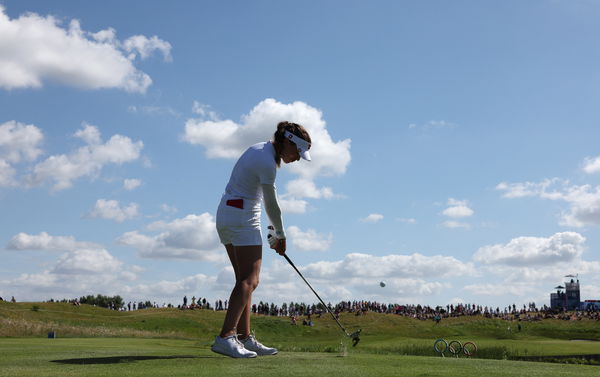

The Open Made Simple: Grab Your Free Fan Guide
Get quick insights, trivia & key storylines. Sign up to grab your copy.

Slow play had made golf almost unwatchable, with rounds often stretching beyond five-and-a-half hours, and fans dubbing the 2024 AIG Women’s Open “barely watchable” due to the glacial pace. So it is no surprise that the LPGA Tour updated its pace of play policies for 2025: 1-5 seconds over time would result in a fine, 6-15 seconds over time would mean a one-stroke penalty, and 16+ seconds over time would lead to a two-stroke penalty. And so, when officials spotted slow play during the 2025 Black Desert Championship in Utah, they enforced the policy!
Officials weren’t messing around when it came to keeping things moving, sending a clear message to the entire field, and young Japanese pro Chisato Iwai felt the sting of this enforcement. During round two, she received a two-stroke penalty for slow play on the par-3 8th hole. The LPGA Media made this public through an X post stating: “Chisato Iwai was assessed a two-stroke penalty for slow play on No. 8 during round two.” This penalty immediately added two strokes to her score and impacted her tournament standing.
She ended up at -1, but what makes it even more consequential is the fact that the cut line was at -3. Iwai missed the cut because of the penalty. This penalty comes as the LPGA is doubling down on its commitment to improving the pace of play. The two-stroke penalty changed Iwai’s score from 70 to 72 for the round.
ADVERTISEMENT
Article continues below this ad
Before 2025, the pace of play violations rarely resulted in stroke penalties (22 players received a fine for slow play last year). That changed dramatically when the LPGA unveiled its new policy in February. Players now face a graduated system of penalties. “This new policy, which was player-led and developed through an established Pace of Play Committee, was created in what we believe is in the best interest of our brand, fans and the overall LPGA watching experience,” said LPGA Player President, Vicki Goetze-Ackerman, in Feb. As a part of this policy, the Rules Officials also issue a warning if they are too slow, but if they are on their last three holes of their round, they might simply be timed without receiving a warning.
- Excessive shot timing: A player can be timed at any time and for any stroke while competing.
- Target timing: The officials have the right to time a player who is not aiding their group’s position because of their slow play.
- Banking time: The pace of play policy still has a cumulative nature in effect, and that allows players to decide how to use their allotted time.
- Violations result in a double fine structure the following year: Fines incurred will double each consecutive year a player is in violation of the policy.
Chisato Iwai was assessed a two-stroke penalty for slow play on No. 8 during round two. @LPGA | @BDChampionship
— LPGA Media (@LPGAMedia) May 3, 2025
World No. 1 Nelly Korda, who has consistently advocated for faster play, enthusiastically welcomed the new policy in February, saying, “Finally, yeah, I’m very excited about it.” She believes stricter enforcement is necessary to save the sport’s appeal, adding, “At the end of the day, we’re a form of entertainment… if we’re taking really long out there, I mean, that’s not entertaining.” Her comments reflect growing frustration among players, fans, and officials with the recurring problem of slow play plaguing women’s professional golf.
ADVERTISEMENT
Article continues below this ad
What’s your perspective on:
Is the LPGA Tour's crackdown on slow play justified, or is it stifling players' natural rhythm?
Have an interesting take?
Contrasting approaches to golf’s pace problem!
Not everyone agrees with these strict measures. Some players argue that quality shots require careful deliberation. They believe rushing could degrade play quality, especially for technical shots around the greens. Meanwhile, other players like Charley Hull have suggested even tougher consequences. “I’m quite ruthless, but I said, listen, if you get three bad timings, every time it’s a two-shot penalty,” Hull stated last year. She proposed that three violations should result in losing tour card privileges, reflecting her frustration after experiencing rounds lasting nearly six hours.
The PGA Tour has taken a different approach by planning to reduce field sizes starting in 2026. This contrasts with the LPGA’s more direct penalty system. The women’s tour recently added a season-long tracking system that tallies timed holes for each player. Those with 40 or more timed holes during the season will face additional fines. This comprehensive approach targets habitual slow players who might otherwise escape notice.
ADVERTISEMENT
Article continues below this ad
Golf’s ongoing pace debate centers on finding the right balance between quality and efficiency. Interim LPGA commissioner Liz Moore’s new policy aims to ” create a more efficient and enjoyable competitive environment.” Early results are promising—at the recent Founders Cup, no group exceeded the target time of four hours and forty-five minutes. So now, whether penalties like Iwai’s will lead to lasting change remains to be seen, but the message is clear: professional golf is serious about speeding up play.
Are strict penalties like Iwai’s necessary to fix golf’s pace problem, or are officials being too harsh on players? Let us know in the comments section below!
ADVERTISEMENT
ADVERTISEMENT
ADVERTISEMENT
ADVERTISEMENT


Is the LPGA Tour's crackdown on slow play justified, or is it stifling players' natural rhythm?